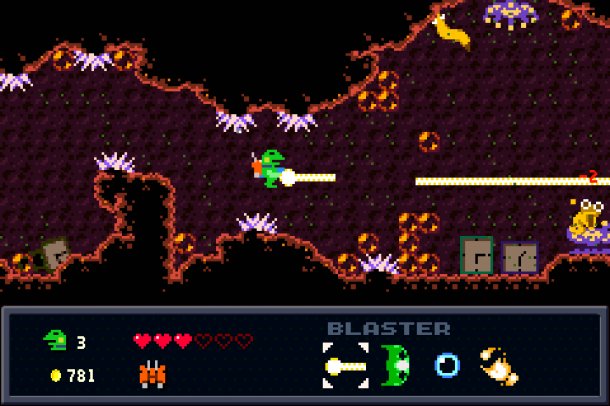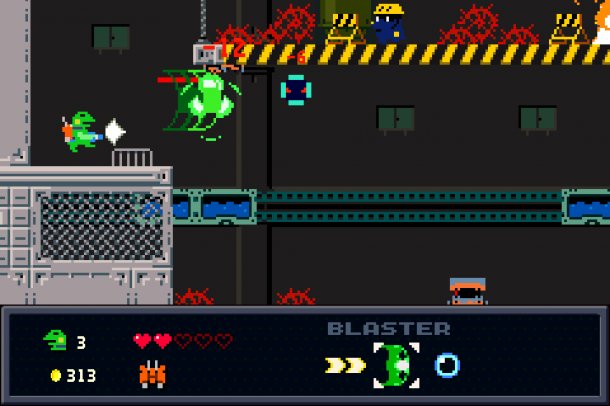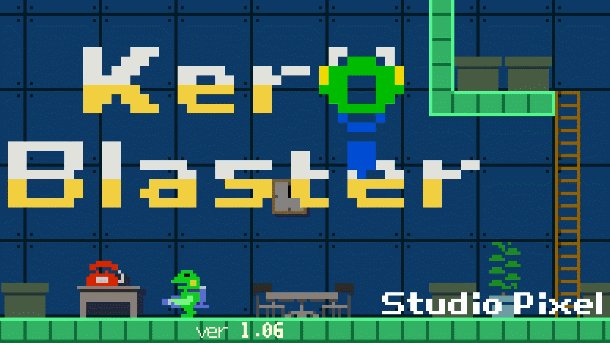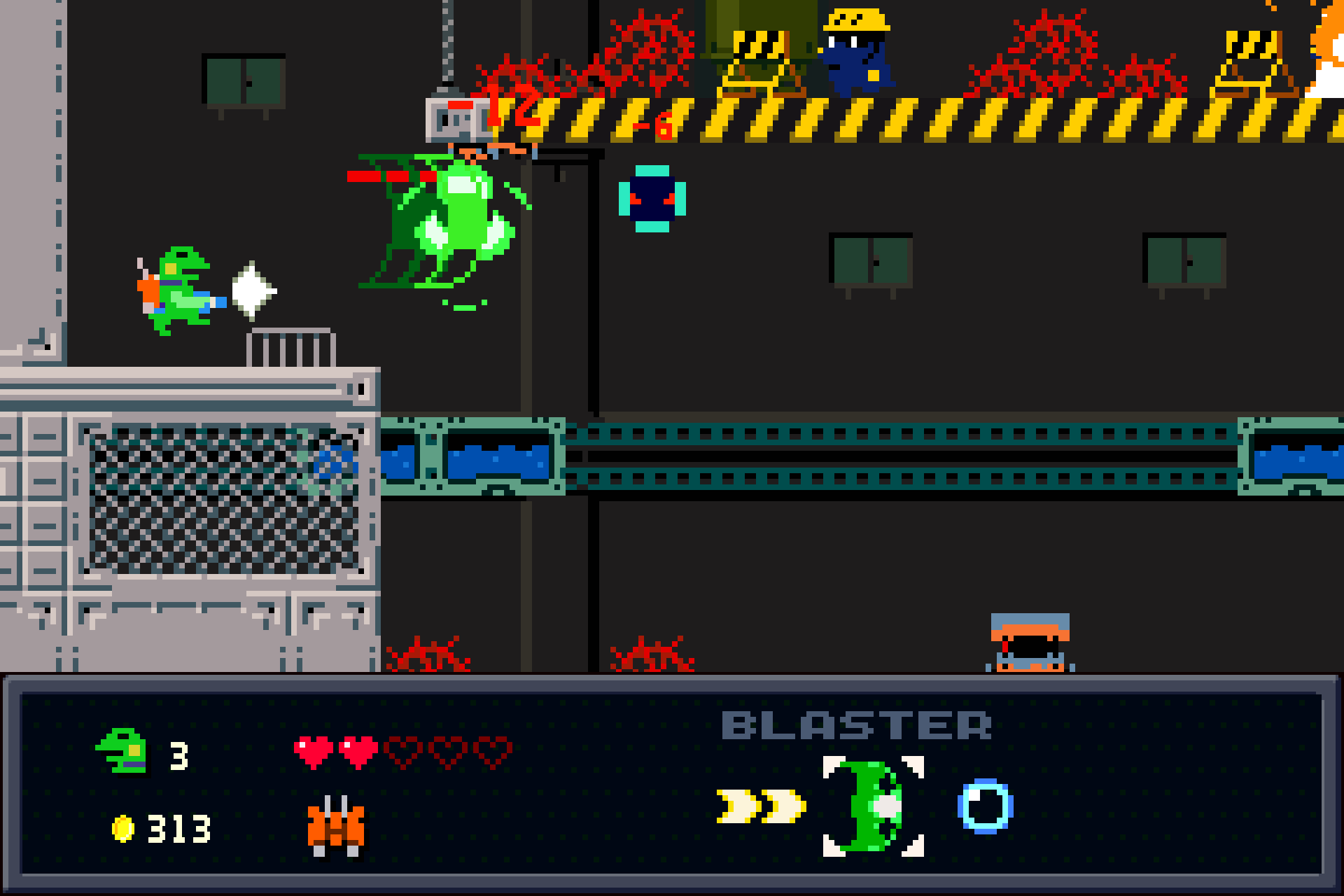Our Verdict
Old-school Japanese shooting, platforming action reminds us just how fun the simple games of the 80s could be.
PC Gamer's got your back
Kero Blaster's chiptune soundtrack is a perfect analogue for the game itself: effortlessly upbeat and cheery one moment, dramatic or laid-back the next, but always sounding like it could've come from an NES if a composer had spent the past 25 years mastering its sound chip. Kero Blaster is a throwback 8-bit shooter without an ounce of waste: its minimalist story sends a hardworking frog through a viney forest, a tumbleweed-swept mesa, and other charming levels filled with somehow more charming enemies.
I wouldn't call Kero Blaster a love letter to the simpler games of the past, because it doesn't wink at you with its pixel graphics and old-school Japanese platforming. Kero Blaster just is one of those games, an NES shooter that happens to run on modern PCs. When I wasn't running out of lives and stuck replaying levels, I was having a great time.
Kero Blaster is Daisuke "Pixel" Amaya's take on NES classic Mega Man. Pixel's last big game was Cave Story, a brilliantly designed shooter every bit as good as its inspiration, Super Metroid. Kero is a far humbler game, carved up into compact levels with none of Cave Story's exploration or hidden backstory. But the link between the two is obvious: the same purity of jumping and shooting is intact, and Kero Blaster ties its levels together with story vignettes focused on a cast of four nameless animal characters. Together they run the business Cat & Frog, which oversees teleporter nodes scattered around the world. When mysterious creatures disable those teleporters, the frog gets stuck with the field work of repairing them.
The Kero rhythm

As Kero Blaster's silent amphibious hero, I blasted my way through a half dozen levels, picking up three new weapons along the way and money to upgrade those weapons and expand my lifebar. My lifebar needed serious expanding. Kero Blaster is not an easy game: every enemy attack takes off a full heart, and with the initial three HP, I died quickly. But Kero Blaster never feels unfair or overwhelms the screen with bullets like Contra: enemies move and attack in learnable, predictable ways.
Some touches of modern design also ease the difficulty. A generous invincibility period after taking damage keeps enemies from killing you with awkward sprite-on-sprite bumbling. The shop allows you to extend your lifebar to survive half a dozen hits. At one point, you get a coat, which Kero Blaster's frog hero wears. It lets him take one hit without damage.
The coat is a big deal.
I was grinning ear-to-ear when I picked up the coat. It's seriously dapper—Resident Evil 4's Leon S. Kennedy rezzed down into an 8-bit frog. I immediately stepped on something spiky and lost the coat. That made me sad. The coat isn't a big deal because it looks cool, though—it's a big deal because Kero Blaster is so deliberately designed that every powerup is a hard-earned addition, and every platform and enemy placement is carefully calculated.
Money accrues like a gold IV drip at first, so I chased every single coin to upgrade my weapons. The frog moves slowly, like a hero of the NES era, and he can't shoot diagonally. Horizontal and vertical attacks require precise positioning to hit enemies and dodge their attacks, which often travel in a straight line. But there are clever ways to avoid those attacks: the bubble powerup reminiscent of Mega Man 2's Bubble Lead shoots a stream of watery orbs that bounce around and roll off ledges.

The enemies are all weird and silly and creative and attack in a fun variety of ways. One hid in a trashcan until I got close. I had to jump to trigger his attack. Another threw coins at me to lure me in, then pelted me with books like the world's lumpiest demon librarian. Each level is short—they took me 10 or 15 minutes when I was playing slowly—and none of them waste time with repeated enemy encounters or drawn-out boss fights. Bosses die quickly to powered-up weapons, and it feels good to kill them without taking damage after a couple pattern-learning deaths.
It's not easy bein' green
I died an embarrassing number of times in Kero Blaster. Enough to feel like I wasn't as good at the game as I should be, since I conquered Cave Story with little difficulty. As much as I appreciated the deliberate pace of progression, I found myself playing through a few levels far too many times. The same thing kept happening: I'd make it most of the way through a level without dying, then get stuck on one particularly hard part (why am I so bad at killing those birds?) or die three times to a boss, which meant starting the level from the beginning. I didn't mind going through a level twice—I was eager to do it better. The third or fourth time, I got a little frustrated.
Around the fifth level, I got over that difficulty hump by grinding enough gold to buy hearts and upgrade my primary weapon. As distinct and potentially interesting as each of Kero Blaster's four weapons are, I stuck with the basic rapidfire gun about 80 percent of the time. The others I only found useful in sporadic situations, and the starter weapon consistently dealt more damage much more quickly. I could have used the other weapons more often, but they rarely seemed like the best tool for the job. In a game that feels so thoughtfully designed and balanced in all other aspects, I was disappointed by how seldom I used Kero Blaster's full arsenal.

I enjoyed Kero Blaster enough to blast through its first few levels a second time in New Game+, and like he did with Cave Story, Amaya's hidden some secrets for that second playthrough. Speedrunning levels in New Game+ with powerups intact is a fun reminder of how far you've come in a few hours, and there's an air of mystery to the story and its characters that sticks with you. Just don't go in expecting Cave Story's grandeur—Kero Blaster is an intentionally short, straightforward game. While dozens of Kickstarters use nostalgia as a selling point, Kero Blaster unassumingly shows how to make an 8-bit platformer for modern PCs with a light contemporary touch. It's refreshing to play a game with such mechanical purity, even if it doesn't do much we hadn't seen by 1993.
Old-school Japanese shooting, platforming action reminds us just how fun the simple games of the 80s could be.

Wes has been covering games and hardware for more than 10 years, first at tech sites like The Wirecutter and Tested before joining the PC Gamer team in 2014. Wes plays a little bit of everything, but he'll always jump at the chance to cover emulation and Japanese games.
When he's not obsessively optimizing and re-optimizing a tangle of conveyor belts in Satisfactory (it's really becoming a problem), he's probably playing a 20-year-old Final Fantasy or some opaque ASCII roguelike. With a focus on writing and editing features, he seeks out personal stories and in-depth histories from the corners of PC gaming and its niche communities. 50% pizza by volume (deep dish, to be specific).


